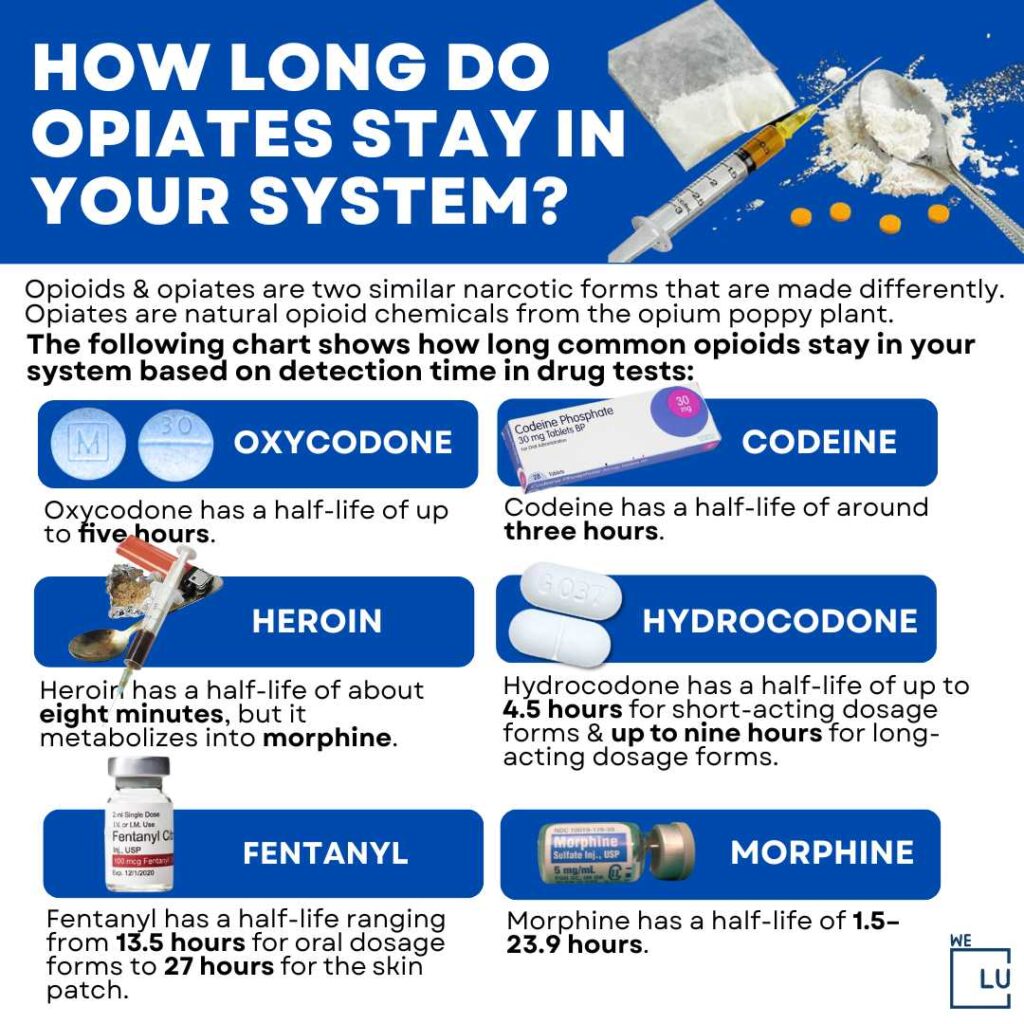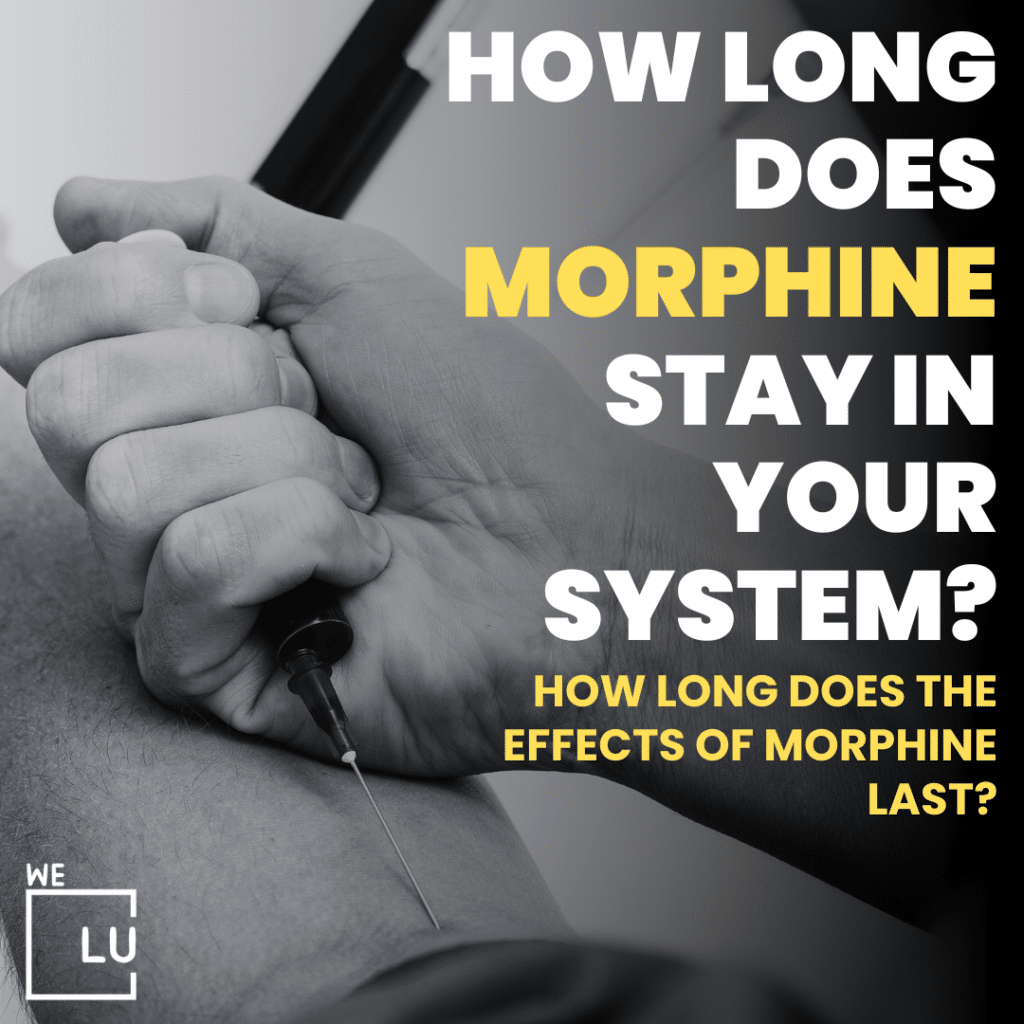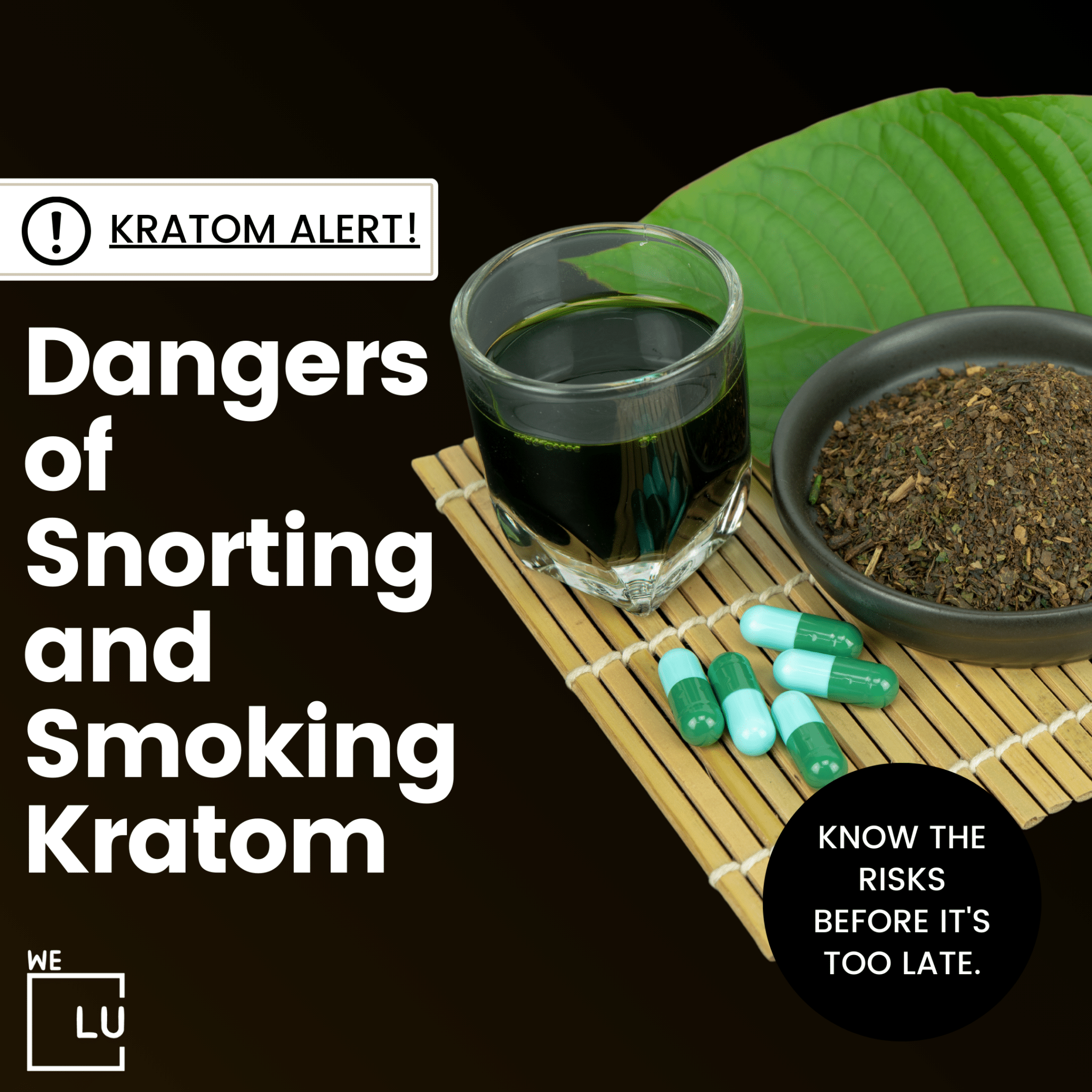What Is Morphine?
Morphine is a potent opioid analgesic derived from the opium poppy plant. The drug is named after Morpheus, the Greek god of dreams, one of humanity’s oldest and most effective pain-relieving medications. Morphine binds specific receptors in the central nervous system, particularly in the brain and spinal cord, to modulate pain signals and relieve severe pain.
Widely used in many treatments, morphine is a cornerstone in managing acute and chronic pain associated with conditions such as surgery, cancer, and specific injuries. Despite its efficacy, morphine carries a risk of side effects and potential for abuse, necessitating careful medical supervision and prescription. The drug is available in various forms, including tablets, injections, and controlled-release formulations, each tailored to address different pain management needs while acknowledging the importance of minimizing the risk of dependence and addiction.
How Long Does Morphine Stay In Your System?
The duration morphine stays in the body can vary based on several factors, including the individual’s metabolism, dosage, frequency of use, and the specific type of drug test being employed. Generally, morphine has a relatively short half-life, which is the time it takes for half of the substance to be eliminated from the body.
How Long Does Morphine Stay In Your Urine?
In the case of a standard urine drug test, morphine is typically detectable for approximately 2 to 3 days after the last dose. However, in chronic users or individuals with slower metabolism, it might be detected for a longer duration, up to 4 days or more.
How Long Does Morphine Stay In Your Blood?
Based on the usual half-life range, morphine is likely to be present in the blood for approximately 8 to 35 hours after the last dose. After a few half-lives, the drug is effectively cleared from the system. It’s important to note that individual variations can influence these estimates.
If a blood test is conducted to detect the presence of morphine, it is generally most accurate within the first day or so after the last dose. After that time, the concentration of morphine in the blood decreases significantly.
How Long Does Morphine Stay In Your Saliva?
The detection window for morphine in saliva is relatively short compared to other biological samples. On average, morphine is typically detectable in saliva for up to 1 to 4 days after the last dose. Saliva tests are commonly employed in various settings, such as workplace drug testing or roadside drug screening. As with any drug testing method, the accuracy and reliability of results depend on proper sample collection and testing procedures.
How Long Does Morphine Stay In Your Hair?
Morphine can be detected in hair follicles for an extended period compared to other biological samples. Hair tests are designed to identify drug use over a more prolonged period, typically ranging from weeks to months. In the case of morphine, it can be detectable in hair for up to 90 days or even longer, depending on the length of the hair sample collected. The timeframe for detection is influenced by factors such as the rate of hair growth and the proximity of the drug use to the hair root. Hair testing is often employed in situations requiring a retrospective analysis of drug use patterns, providing a more comprehensive overview compared to other testing methods.
| Drug Test Type | Detection Time Range |
|---|---|
| Urine Test | 2 to 4 days, possibly longer in chronic users |
| Blood Test | Approximately 8 to 35 hours |
| Saliva Test | Up to 1 to 4 days |
| Hair Test | Up to 90 days or longer, depending on hair growth |
How Long Do Opiates Stay In Your System?


Skip To:
Learn More:
- How long do opiates stay in your system? Specifics, Addiction, Drug Processing & Treatment
- Morphine Vs Oxycodone, Is Morphine Stronger Than Oxycodone?
- Morphine Withdrawal Symptoms, Timeline, Detox, & Treatments
- Morphine Addiction, Signs, Symptoms, And Treatments
- Is There A Poppy Seed Drug? Poppy Seed Effects On Drug Test
- Opiate Addiction Overdose, Symptoms & Treatment
- Opiate Withdrawal, Effects, Causes, Symptoms, Diagnosis, Complications, Detox & Treatments
- Opiate Detox Withdrawal Effects, Symptoms & Treatment
How Long Does The Effects Of Morphine Last?
The duration of morphine’s effects can vary depending on the route of administration, the specific formulation of the drug, and individual factors such as metabolism and tolerance. Generally, the onset and duration of effects are as follows:
| Route of Administration | Onset of Effects | Duration of Effects |
|---|---|---|
| Intravenous (IV) | Immediate | 4 to 5 hours |
| Oral (Immediate-Release Formulation) | 30 minutes to 1 hour | 4 to 6 hours |
| Extended-Release Formulations (e.g., MS Contin) | Varies, typically within 1 to 2 hours | Up to 12 hours or longer |
Individual responses to morphine can vary, and factors such as the patient’s overall health, tolerance to opioids, and the presence of other medications can influence the duration of the drug’s effects. Healthcare professionals carefully consider these factors when prescribing morphine to ensure optimal pain management while minimizing the risk of side effects.
Patients prescribed morphine should follow their healthcare provider’s instructions regarding dosage and administration. Adjustments to the medication regimen should only be made under the guidance of a healthcare professional to ensure safe and effective pain management. Abruptly stopping or changing the dose of morphine without proper medical supervision can lead to withdrawal symptoms and other potential complications.

Get Your Life Back
Find Hope & Recovery. Get Safe Comfortable Detox, Addiction Rehab & Dual Diagnosis High-Quality Care.
Hotline (855) 695-1160Factors That Affect How Long Morphine Lasts
- Metabolism: Individual variations in metabolism can affect how quickly the body processes and eliminates morphine. Faster metabolism may result in quicker clearance of the drug.
- Dosage and Formulation: The dose of morphine and the specific formulation (immediate-release or extended-release) can impact the duration of effects. Higher doses and extended-release formulations generally have a more prolonged effect.
- Route of Administration: How morphine is administered (e.g., intravenous, oral) affects how quickly it reaches the bloodstream and, consequently, the onset and duration of its effects.
- Tolerance: Chronic use of morphine can lead to the development of tolerance, requiring higher doses to achieve the same level of pain relief. Tolerance can also influence how long the effects are perceived.
- Individual Health Factors: Overall health, liver function, kidney function, and other health factors can influence how the body processes and eliminates morphine.
- Age: Age can impact the metabolism and elimination of drugs. Elderly individuals may metabolize drugs more slowly than younger individuals.
- Presence of Other Medications: Interactions with other medications can affect the metabolism of morphine. Certain drugs may inhibit or enhance the effects of morphine.
- Body Composition: Factors such as body weight and fat content can influence the distribution and elimination of morphine.
- Hydration and Kidney Function: Adequate hydration supports kidney function, and proper kidney function is crucial for eliminating drugs, including morphine.
- Individual Response: Each person may respond differently to morphine based on their unique physiology and sensitivity to the drug.

Get Help. Get Better. Get Your Life Back.
Searching for an Accredited Drug and Alcohol Rehab Centers in Near You?
Even if you have failed previously and relapsed, or are in the middle of a difficult crisis, we stand ready to support you. Our trusted behavioral health specialists will not give up on you. When you feel ready or just want someone to speak to about therapy alternatives to change your life call us. Even if we cannot assist you, we will lead you to wherever you can get support. There is no obligation. Call our hotline today.
FREE Addiction Hotline – Call 24/7
Morphine Half Life
The half-life of morphine can vary depending on the specific formulation of the drug and individual factors. The half-life is the time it takes for half of the drug to be eliminated from the body. In general, the half-life of morphine falls within the range of approximately 1.5 to 7 hours.
| Formulation of Morphine | Half-Life Range |
|---|---|
| Immediate-Release | Approximately 1.5 to 4.5 hours |
| Extended-Release (e.g., MS Contin) | Approximately 3 to 7 hours |
Individual variations, such as metabolism, age, and overall health, can influence the actual half-life experienced by a person. Additionally, the half-life is a critical consideration for determining dosing intervals and understanding how long the effects of the drug may last in a given individual. Always follow the prescribed dosage and administration instructions provided by healthcare professionals.
Comfortable Facilities & Amenities
High-Quality Addiction & Mental Health Rehabilitation Treatment
Rehab Centers TourRenowned California Addiction Center. Serene Private Facilities. Inpatient rehab programs vary.
Addiction Helpline (855) 695-1160Proven recovery success experience, backed by a Team w/ History of:
15+
Years of Unified Experience
100s
5-Star Reviews Across Our Centers
10K
Recovery Success Stories Across Our Network
- Low Patient to Therapist Ratio
- Onsite Medical Detox Center
- Comprehensive Dual-Diagnosis Treatment
- Complimentary Family & Alumni Programs
- Coaching, Recovery & Personal Development Events
Can You Get Withdrawals From Morphine?
Discontinuing or reducing the use of morphine can lead to withdrawal symptoms due to the development of physical dependence. Morphine, an opioid analgesic, binds to specific receptors in the central nervous system, and with prolonged use, the body adapts to its presence. When the intake of the drug is suddenly stopped or if the dosage is significantly decreased, the body reacts with a range of withdrawal symptoms.
Withdrawal symptoms from morphine can include flu-like symptoms such as runny nose, sneezing, and body aches; gastrointestinal issues like nausea and diarrhea; psychological symptoms including anxiety and irritability; autonomic symptoms like sweating and dilated pupils; and sleep disturbances such as insomnia. While withdrawal symptoms are generally not life-threatening, they can be highly uncomfortable and distressing.
To manage the withdrawal process and minimize the risk of complications, healthcare professionals often recommend a gradual tapering of the morphine dosage under medical supervision. This allows the body to adjust more smoothly and reduces the intensity of withdrawal symptoms. Individuals considering discontinuation or dose reduction of morphine should consult with their healthcare provider to create a personalized plan that addresses their specific needs and ensures a safe transition.

World-class, Accredited, 5-Star Reviewed, Effective Addiction & Mental Health Programs. Complete Behavioral Health Inpatient Rehab, Detox plus Co-occuring Disorders Therapy.
CALL (855) 695-1160End the Addiction Pain. End the Emotional Rollercoaster. Get Your Life Back. Start Drug, Alcohol & Dual Diagnosis Mental Health Treatment Now. Get Free No-obligation Guidance by Substance Abuse Specialists Who Understand Addiction & Mental Health Recovery & Know How to Help.
Morphine Withdrawal Symptoms
Morphine withdrawal symptoms can manifest when an individual who has been using morphine regularly reduces their dosage or stops taking the drug. These symptoms result from the development of physical dependence on the opioid. Common morphine withdrawal symptoms include:
- Flu-Like Symptoms:
- Runny nose.
- Sneezing.
- Body aches.
- Gastrointestinal Distress:
- Nausea.
- Vomiting.
- Diarrhea.
- Psychological Symptoms:
- Anxiety.
- Irritability.
- Restlessness.
- Autonomic Dysregulation:
- Sweating.
- Dilated pupils.
- Changes in blood pressure and heart rate.
- Sleep Disturbances: Insomnia
The severity and duration of morphine withdrawal symptoms can vary based on factors such as the individual’s overall health, the duration of morphine use, and the rate at which the drug is discontinued. To manage withdrawal and reduce the risk of complications, healthcare professionals often recommend a gradual tapering of the morphine dosage under medical supervision. This approach helps the body adjust more smoothly and minimizes the intensity of withdrawal symptoms. If someone is experiencing withdrawal symptoms or considering discontinuing morphine, seeking guidance from a healthcare provider is crucial to ensure a safe and supportive process.
What’s The Use Of Drug Testing?
Drug testing serves as a crucial tool in identifying and addressing drug abuse. In employment settings, drug tests are often utilized during hiring processes or as part of routine screenings, influencing job status and potential consequences for positive results. Legal systems frequently employ drug testing as a condition of probation, parole, or participation in drug court programs, linking results to legal outcomes.
Educational institutions may implement testing for students involved in extracurricular activities, as they are aiming to promote a drug-free environment. Athletes face drug testing to maintain fair competition and adhere to anti-doping regulations. Moreover, within addiction treatment, regular drug testing helps monitor compliance, track progress, and identify potential relapses. While drug testing is a valuable deterrent, its effectiveness is maximized when integrated into comprehensive approaches that encompass prevention, education, and supportive treatment for individuals navigating the complexities of drug abuse.
Experience Transformative Recovery at the We Level Up California Treatment Center.
See our authentic success stories. Get inspired. Get the help you deserve.



Start a New Life
Begin with a free call to an addiction & behavioral health treatment advisor. Learn more about our dual-diagnosis programs. The We Level Up treatment center network delivers recovery programs that vary by each treatment facility. Call to learn more.
- Personalized Care
- Caring Accountable Staff
- World-class Amenities
- Licensed & Accredited
- Renowned w/ 100s 5-Star Reviews
We’ll Call You
How Long Do Opiates Stay in Your System? How Long Do Opiates Stay in Urine, Blood, & Body?
Search We Level Up CA How Long Does Morphine Stay In Your System, Drug & Alcohol Rehab / Detox & Mental Health Topics & Resources
Sources
- Smith ML, Shimomura ET, Summers J, Paul BD, Nichols D, Shippee R, Jenkins AJ, Darwin WD, Cone EJ. Detection times and analytical performance of commercial urine opiate immunoassays following heroin administration. J Anal Toxicol. 2000 Oct;24(7):522-9. doi: 10.1093/jat/24.7.522. PMID: 11043654. https://pubmed.ncbi.nlm.nih.gov/11043654/ Read More: how long does morphine last, morphine half life, half life of morphine, how long does morphine stay in your urine, how long will morphine stay in your system, how long does morphine stay in urine, how long does morphine stay in your body, how long will morphine stay in your urine, how long does morphine stay in your blood,
- Vandevenne M, Vandenbussche H, Verstraete A. Detection time of drugs of abuse in urine. Acta Clin Belg. 2000 Nov-Dec;55(6):323-33. doi: 10.1080/17843286.2000.11754319. PMID: 11484423. https://pubmed.ncbi.nlm.nih.gov/11484423/ Read More: how long does morphine last, morphine half life, half life of morphine, how long does morphine stay in your urine, how long will morphine stay in your system, how long does morphine stay in urine, how long does morphine stay in your body, how long will morphine stay in your urine, how long does morphine stay in your blood,
- WHO Guidelines for the Pharmacological and Radiotherapeutic Management of Cancer Pain in Adults and Adolescents. Geneva: World Health Organization; 2018. ANNEX 6, Pharmacological Profiles and Opioid Conversion Tables. Available from: https://www.ncbi.nlm.nih.gov/books/NBK537482/
- Murphy PB, Bechmann S, Barrett MJ. Morphine. [Updated 2023 May 22]. In: StatPearls [Internet]. Treasure Island (FL): StatPearls Publishing; 2023 Jan-. Available from: https://www.ncbi.nlm.nih.gov/books/NBK526115/
- DEA – Morphine – https://www.dea.gov/factsheets/morphine
- Medline Plus – Morphine – https://medlineplus.gov/druginfo/meds/a682133.html
- US Equal Employment Opportunity Commission (EEOC) – Use of Codeine, Oxycodone, and Other Opioids: Information for Employees – https://www.eeoc.gov/laws/guidance/use-codeine-oxycodone-and-other-opioids-information-employees
- Cohen B, Ruth LJ, Preuss CV. Opioid Analgesics. [Updated 2023 Apr 29]. In: StatPearls [Internet]. Treasure Island (FL): StatPearls Publishing; 2023 Jan-. Available from: https://www.ncbi.nlm.nih.gov/books/NBK459161/
- Chou R, Hartung D, Turner J, et al. Opioid Treatments for Chronic Pain [Internet]. Rockville (MD): Agency for Healthcare Research and Quality (US); 2020 Apr. (Comparative Effectiveness Review, No. 229.) Available from: https://www.ncbi.nlm.nih.gov/books/NBK556253/
- National Academies of Sciences, Engineering, and Medicine; Health and Medicine Division; Board on Health Sciences Policy; Committee on Pain Management and Regulatory Strategies to Address Prescription Opioid Abuse; Phillips JK, Ford MA, Bonnie RJ, editors. Pain Management and the Opioid Epidemic: Balancing Societal and Individual Benefits and Risks of Prescription Opioid Use. Washington (DC): National Academies Press (US); 2017 Jul 13. Available from: https://www.ncbi.nlm.nih.gov/books/NBK458660/ doi: 10.17226/24781
- Zullo AR, Danko KJ, Moyo P, et al. Prevention, Diagnosis, and Management of Opioids, Opioid Misuse, and Opioid Use Disorder in Older Adults [Internet]. Rockville (MD): Agency for Healthcare Research and Quality (US); 2020 Nov. (Technical Brief, No. 37.) Available from: https://www.ncbi.nlm.nih.gov/books/NBK564144/
- Clinical Guidelines for Withdrawal Management and Treatment of Drug Dependence in Closed Settings. Geneva: World Health Organization; 2009. 4, Withdrawal Management. Available from: https://www.ncbi.nlm.nih.gov/books/NBK310652/




